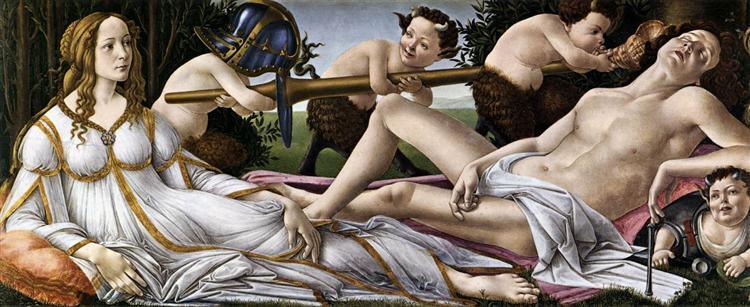Description
In Sandro Botticelli's Venus and Mars, the artist depicts a scene from Greco-Roman mythology that portrays the god of war, Mars, alongside the goddess of love, Venus, in a rather compromising position.
After making passionate love, Mars lies in front of Venus, asleep, snoring, nearly naked, and exhausted from intercourse. Venus, on the other hand, remains calm and collected, fully clothed, the very picture of perfection. The goddess's hair appears to be woven into the fabric of her dress.
By depicting the gods as such, Botticelli empowers the female body, having "conquered" Mars. In this way, the painting becomes an allegory for the notion that love defeats war.
This painting commissioned by the Vespucci family in late 15th century Florence originally served as a wedding present for a bride. These types of paintings were normally hung in a multipurpose room called a chamber. People would bring their guests into the chamber to flaunt their prized possessions, including art pieces like this one, family portraits, and the like. Also, when a man and his wife tried to conceive a child, they did so on camera. They believed that when a woman looks at a beautiful man before having sex, it increases her chance of conceiving a male child, hence the immaculate male form of Mars surrounded by tiny baby cupids.
In this painting, Botticelli depicts the putti as satyrs, who in Greco-Roman mythology are drunken, perpetually excited half-man, half-goat creatures who feasted all the time. The word satirical, which means lascivious and lustful person, originates from this mythological creature. In classical art, satyrs are typically depicted with human bodies, goat's feet, a tail, ears, and a massive, raging erection. The technical term for these half-man, half-goat erections is ithyphallic. This vocabulary word is not relevant to understanding this painting, but it is interesting that there is a technical term for satyr erections. Botticelli's clever depiction of putti as satyrs combines the representation of love (cupids) with sex and fertility (satyrs). Although the artist depicts the satyrs on Venus and Mars as infants rather than full-grown men with exaggeratedly erect penises, the historical and mythological context of these creatures directly relates to the purpose of this commission as a wedding gift for a newlywed couple. .
Some art historians believe that the wasps near Mars' ear are a reference to the sting of love, while others insist that it is a reference to the Vespucci family because the word for wasp in Italian is vespe. Another fun detail is the satyr looking out at the audience through the armor of Mars, ready to wake Mars from his deep sleep. With so many rich images, Botticelli captures a playfulness and humor that would have been appreciated by viewers in the original context of the work, and is still enjoyed and celebrated today.
On Venus and Mars, Venus, look far away at Mars. His muscular body is as limp as his dropped finger, his head tilted back as he sleeps. Venus is victorious in this sexual encounter, while Mars is completely lost in sleep.
Venus was married to the god Vulcan, an unattractive blacksmith. When he found out that Venus had been unfaithful to him, he made a fine web of chains to catch her in the act. The net was so delicate that the two beautiful gods did not know they had been captured until it was too late. Vulcan invited all the gods of Mount Olympus to come and laugh at the trapped lovers.
Botticelli has approached the story with a sense of humor, including many playful details intended to amuse his client. Marte is so sound asleep that he doesn't realize that a satyr has stolen his spear and helmet. Another has tucked into the cuirass (body armor) below his elbow. He is not awakened by the sound of the conch, which one of the mischievous creatures blows in his ear. Noise and commotion have disturbed the hornet's nest, and a swarm of fat insects buzzes around your head as Mars continues to sleep despite all the activity around him. The shell was a symbol of Venus, who was born from the sea, almost visible in the distance.
Botticelli's association with Lorenzo de' Medici, known as Lorenzo the Magnificent, meant that the painter was in contact with all the contemporary scholars and poets who came and went at court. Lorenzo de' Medici was a fan of classical culture and surrounded himself with people well versed in these subjects.
Perhaps not surprisingly, then, that there is an ancient account that matches the images of the playful satyrs in this image. It is the description of the Roman writer Lucian of a painting that shows the marriage of Alexander the Great with Roxana. In that image, little cupids play with the armor of the warrior Alexander, two raising his spear and another crawling up to his breastplate. Botticelli has turned the cupids into satyrs, which could show his knowledge of a poem by the scholar and poet Angelo Poliziano, who tutored the Medici children. Poliziano's poem, written around the same time this painting was made, mentions "little goat-legged satyrs." They were companions to a sleeping shepherd who inhabited a dream place of love and pleasure. Perhaps Botticelli was inspired by this poem, which he may well have known. This possible combination of sources of inspiration reflects the artist's extensive knowledge of ancient and contemporary culture.
Botticelli also displays his knowledge of ancient sculpture, so fashionable in Florence at the time. Marte's left foot is caught in the pink cloth. This unusual detail could be a deliberate reference to a well known and admired ancient sculpture, the Sleeping Hermaphrodite.
Also seen in the work are the braids of Venus's hair that are attached to her dress, forming a border that is secured with a jewel, making her dress impossible to remove. Perhaps Botticelli intended to emphasize the chastity of the Goddess, despite her infidelity. Her blonde hair, pale skin, and red lips are a nod to the contemporary ideal of female beauty represented in poetry. Venus here looks more like a contemporary Florentine beauty, or perhaps even an image of the Virgin Mary , than classical sculpture, and quite different from the nude goddess Botticelli painted in his painting The Birth of Venus .




